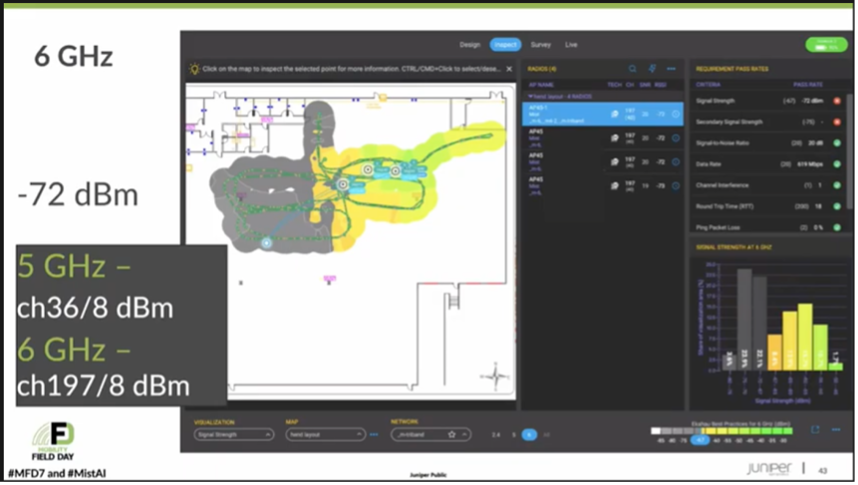Juniper’s Take on Real-World 6GHz Performance
At Mobility Field Day 7, Juniper presented on Wi-Fi 6E (6GHz) design and its adoption in the real world based on several months of data collected from the field. One thing that stood out was the contrast between uplink and downlink for 6GHz devices.
In the downstream direction, Juniper demonstrated client devices measure similar signal strength and quality regardless of connecting on either the 5GHz or 6GHz band. Data points come from both Windows utility and as measured by Ekahau (see further below).
There was a stark contrast in the performance between client devices on the 5GHz and 6GHz band in the upstream direction. Asymmetric upstream and downstream signal strengths lead to a significant variance between data rates in the two directions. Results captured in the chart below show lower RSSI received at the AP from signals sent by clients.

In addition to this, survey data was collected on both the 5GHz and 6GHz bands using Ekahau. The data was collected prior to the Ekahau announcement on July 21 so there was a little hand waving with regard to how the 6GHz data was collected. The image below shows signal coverage (RSSI) on the 5GHz band.

The image below shows signal coverage (RSSI) on the 6GHz band as roughly equivalent to what was measured on 5GHz above. It appears, at least from the client device performing the measuring (SK2), that 5GHz and 6GHz present similar coverage in the downstream direction from the AP.

Note, 6GHz channels were configured using 80MHz channel width. Due to physics, each time the channel width doubles (2x) the noise floor increases by 3dB. Traditionally, in the 5GHz band this effect resulted in a SNR loss of 3dB each time the channel width doubled. This effect is neutralized in 6GHz with a corresponding increase in the Tx power to offset the increase in noise floor. As a result, the SNR, and therefore signal quality, remains consistent across the 6GHz band.
What is causing the data difference?
Low power indoor (LPI) clients are significantly constrained with respect to their maximum Tx Power. As a result, clients effectively whisper when talking to the AP. Low SNR values from clients make it challenging for 4×4 access points to successfully demodulate complex signals, resulting in increased retransmissions and lower sustained data rates.
I find this result a little strange. To begin with, link budgets are often greater in the uplink direction. Even with a greater AP transmit power, the upstream link budget is often greater or on par with downstream link budgets due to a couple of factors:
- Higher performance radios = greater receive sensitivity – Enterprise APs use high end radios resulting in increased receive sensitivity compared to typical clients.
- MRC (maximal ratio combining) or “more ears” – APs typically have more radio chains than clients, allowing them to capture more RF signal and perform advanced digital signal processing resulting in increased gain. With double the number of receive chains the AP enjoys a 3dB gain due to MRC.
The observed lower data rates make me wonder about the effectiveness of MRC and if perhaps it is a better idea to deploy 8×8 APs versus 4×4 in high density 6GHz environments to help compensate for these issues.
Based on the data, Juniper summarized their recommendations and insights for 6GHz design with the following guidelines:
Signal difference between 5GHz and 6GHz varies A LOT in the upstream direction, the largely due to the constraint of client Tx power in 6GHz.
Typical downstream (AP-to-Client) performance varies 0-5dB between 5 and 6GHz.
Typical upstream (Client-to-AP) performance varies 6-12dB (or more) between 5 and 6GHz.
RRM uses ML/AI to smooth the downstream delta, but it cannot break the laws of physics and fix the upstream delta.
At the end of the day, Juniper believes 6GHz designs will require higher AP density and smaller AP cells to compensate for these results.

Slàinte!
Resources:
All MFD7 presentations are available on the MFD7 YouTube channel here.
Juniper AP45 Access Point Data Sheet
https://www.juniper.net/content/dam/www/assets/datasheets/us/en/access-points/ap45.pdf
Ekahau releases Sidekick 2 on July 21
Video: Ekahau Sidekick 2 | 6 GHz Survey Speed & Accuracy
Juniper AI-Driven Enterprise: Wireless – Wes’ presentation from MFD7
Disclaimer
Gestalt IT (Mobility Field Day organizer) paid for all my travels, lodging, and subsistence expenses to be a delegate at Mobility Field Day 7. I did not receive any compensation in any form to be a delegate, to write or publicize Mobility Field Day by either Gestalt IT or the presenting organization.